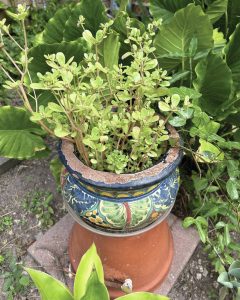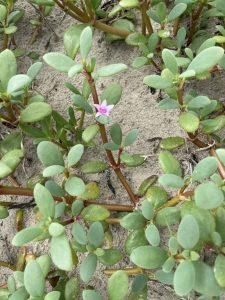 A rescued Common Purslane as a patio pot specimen. (Anita Westervelt | Courtesy photo)
A rescued Common Purslane as a patio pot specimen. (Anita Westervelt | Courtesy photo)As summer approaches, scorching afternoon temperatures might make for a stressed-looking garden, leaving the hardiest plants those that are coming up between the cracks of a sidewalk.
One interloper in that popular venue is an annual succulent called common purslane, portulaca oleracea. It starts small, a few tiny, round green leaves, sometimes edged in lavender or red. Left on its own, it can develop into a sturdy mound about 6 inches tall and a foot in diameter.
I find a couple of volunteer plants at the semi-shaded walkway near the back of our house each year. I keep them. They have a tap root, but nothing strong enough to damage a walkway. Tucked beneath other garden plants, common purslane can easily be overshadowed. A sidewalk version allows the plant to realize its rightful duties as a useful habitat member to local wildlife. No part goes to waste.
It blooms spring through November, producing tiny flowers with brilliant yellow petals and yellow stamen that open during the morning hours. The flowers attract pollinators, flies, small bees, and beetles. Butterflies draw nectar from the flowers.
Rodents, squirrels, rats and mice eat the flowers. Sparrows, and other birds, eat the seeds; one common purslane plant can produce up to 200,000 seeds — that’s a lot of bird food. Herbivores eat the leaves. It is a larval plant to a variety of sawflies called purslane blotchmine sawfly and a host plant to purslane, salt marsh and white-lined sphinx moths.
Earlier this year, as an experiment, I rescued a young specimen from the lawn, gently digging it up and potting it in an old pot. I stacked it atop a larger, upturned pot to give it height and displayed it in partial shade near the porch. The fleshy leaves and stems retain moisture; potted up though, if it begins looking shriveled, it needs more frequent watering. Those in the ground and between the cracks of a sidewalk fare better in the heat and drought.
Common purslane has an ancient worldwide distribution: Some of the earliest explorers in the Americas found the plant already growing, and seeds of this plant have been found in archaeological sites.
In the garden, the stems will branch and sprawl, but not root from the nodes that touch the soil. It is remarkably maintenance free and will take care of itself all summer long.
 Sea Purslane is seen blooming at the beach. (Anita Westervelt | Courtesy photo)
Sea Purslane is seen blooming at the beach. (Anita Westervelt | Courtesy photo)A close cousin to common purslane is best visited at the beach. Sea purslane, Sesuvium portulacastrum, a prostrate perennial, has a more far-reaching spread and is a rapidly growing important plant in coastal dune stabilization.
I photographed a young plant on the beach, beginning life in near-perfect symmetry. It will soon clamber across the sand, rooting periodically and forming a large dense mat. Sea purslane is especially well adapted to salt, sand and sea-spray; stems and leaves are more waxy than common purslane, which reduce water loss. Tiny pink to purple five-petaled flowers open briefly around midday. They are pollinated by bees and produce a many-seeded capsule; the seeds do not float.
Anita Westervelt is a Texas Master Naturalist.
The post Portulacas and fun plants to observe at the beach and inland appeared first on MyRGV.com.
 (2).png)
 3 months ago
98
3 months ago
98








 English (US)
English (US)